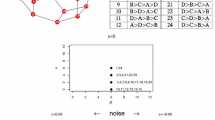Abstract
In a three-candidate election, a scoring rule λ, λ∈[0,1], assigns 1,λ and 0 points (respectively) to each first, second and third place in the individual preference rankings. The Condorcet efficiency of a scoring rule is defined as the conditional probability that this rule selects the winner in accordance with Condorcet criteria (three Condorcet criteria are considered in the paper). We are interested in the following question: What rule λ has the greatest Condorcet efficiency? After recalling the known answer to this question, we investigate the impact of social homogeneity on the optimal value of λ. One of the most salient results we obtain is that the optimality of the Borda rule (λ=1/2) holds only if the voters act in an independent way.
Similar content being viewed by others
REFERENCES
Berg, S. (1985), Paradox of voting under an urn model: the effect of homogeneity, Public Choice 47: 377–387.
Black, D. (1958), The Theory of Committees and Elections (Cambridge: Cambridge University Press).
Condorcet, Marquis de (1785), Essai sur l'Application de l'Analyse à la Probabilité des Décisions Rendues à la Pluralité des Voix. Académie des Sciences, Paris.
Fishburn, P.C. & Gehrlein, W.V. (1976), Borda's rule, positional voting, and Condorcet's simple majority principle, Public Choice 28: 79–88.
Gehrlein, W.V. (1995), Condorcet efficiency and social homogeneity, in W.A. Barnett, H. Moulin, M. Salles & N.J. Schofield (eds), Social Choice, Welfare, and Ethics, pp. 127–143 (Cambridge: Cambridge University Press).
Gehrlein, W.V. (1997), Condorcet's paradox and the Condorcet efficiency of voting rules, Mathematica Japonica 45: 173–199.
Gehrlein, W.V. & Berg, S. (1992), The effect of social homogeneity on coincidence probabilities for pairwise proportional lottery and simple majority rules, Social Choice and Welfare 9: 361–372.
Gehrlein, W.V. & Fishburn, P.C. (1978), Coincidence probabilities for simple majority and positional voting rules, Social Science Research 7: 272–283.
Johnson, N.L. & Kotz, S. (1977), Urns Models and their Application (New York, Wiley).
Lepelley, D. (1992), Une caractérisation du vote à la majorité simple, Recherche Opérationnelle / Operation Research, 26: 361–365.
Lepelley, D. (1993), On the probability of electing the Condorcet loser, Mathematical Social Sciences 25: 105–116.
Lepelley, D. (1995), Condorcet efficiency of positional rules with single-peaked preferences, Economic Design 1: 289–299.
Lepelley, D. & Gehrlein, W.V. (1999), A note on the probability of having a strong Condorcet winner, Quality and Quantity 33: 85–96.
Lepelley, D. & Merlin, V. (1998), Choix social positionnel et principe majoritaire, Annales d'Economie et de Statistique 8: 29–48.
Newenhizen, J. van (1992), The Borda method is most likely to respect the Condorcet principle, Economic Theory 2: 69–83.
Tataru, M. & Merlin, V. (1997), On the relationship of the Condorcet winner and positional voting rules, Mathematical Social Sciences 34: 81–90.
Rights and permissions
About this article
Cite this article
Lepelley, D., Pierron, P. & Valognes, F. Scoring Rules, Condorcet Efficiency and Social Homogeneity. Theory and Decision 49, 175–196 (2000). https://doi.org/10.1023/A:1005257316414
Issue Date:
DOI: https://doi.org/10.1023/A:1005257316414




